论文FANS: Fuzzing Android Native System Services via Automated Interface Analysis阅读笔记和代码阅读笔记
FANS: Fuzzing Android Native System Services via Automated Interface Analysis [29th USENIX]
文章提出了一个全自动化fuzz安卓原生系统服务的工具。
依照AOSP编译流程,扫描涉及interface的相关代码源文件,得到所有interface基本信息
通过对interface model的理解,生成合法的输入进行测试。
测试框架采用CS架构,建立在多台测试真机和服务器之上,发现了若干漏洞和exception。
Knownledge
Android native system service
binder & RPC
challenges
- Android原生系统服务通过基于Binder的特定接口唤醒,所以需要自动识别并生成针对性的测试用例。
- 有效的测试用例需要满足对应的接口模型。
- 有效的测试用例还得满足语义要求,包括变量依赖和接口依赖
routine
- 首先收集目标服务中所有的interface和nest-interface。
- 然后提取interface model以及interface AST,包括transaction code, variable name, variable type in transaction data。
- 基于variable name&type推断variable dependency,基于生成和使用关系推断interface dependency。
- 基于以上的interface model和dependency知识,生成语义语法合规的sequence of transactions。
- 实验在6台Android9机器上进行,从数千个crash中发现了20个vulnerabilities,20个已经被Google确认。以及138个Java exceptions。
1 Introduction
1.1 Related Work
BinderCracker
通过记录调用来获取target service model。
不能获取准确的输入语义知识(变量名和变量类型),也不能获取rare interface和nested interface。
Chizpufle
改进BinderCracker: 使用反射技术获取目标interface的参数知识,用于fuzz厂商预置的Java服务。
但是不能测试Android原生系统服务。
1.2 Challenges&Approaches
interface识别:top-level&multi-level【Location】
【现状】
top-level会在ServiceManager中完成注册,multi-level interface通过top-level interface被获取。
多数interface通过AIDL定义,C++定义或者动态生成的interface是少数(之前的研究没有找到统一规律)。
【解决】
扫描Service注册操作,得到所有的top-level interface
扫描writeStrongBinder方法得到所有的multi-level interface。(deep interface通过调用该方法动态生成)interface model extraction【Grammar】
【现状】
对于每个interface,需要找到支持的transactions列表。
需要确定interface输入数据的格式,且每个transaction有自己的输入数据格式,需要完全的自动化。
【解决】考虑到Android总是使用一系列特定的方法来实现序列化和反序列化(readInt32, writeInt32),所以可以通过识别这些方法的调用序列,推断出interface的输入语法。
为了维护变量的名字和类型,这里建立了发序列化操作的AST。语义合法的输入生成【Semantic】
【现状】
Android会有安全检查(Sanity Check),因此输入的data需要语义合法。
语义要求包括变量名、变量类型、变量依赖、interface依赖以及变量和interface之间的依赖,比较难提取。
【解决】
通过2中获取的变量名和类型的知识,识别transaction内的变量依赖。
依赖transaction会反序列化被依赖transaction序列化的data,由此可以建立transaction之间的依赖关系。
通过生成&使用关系推断interface之间的依赖关系。
2 Background
2.1 Android System Service
category
Java System Service[Java: Activity Manager]
Native System Service[C++: Camera Service]
Services in normal domain, vendor domain, hardware domain。
Application-Service Communication Model
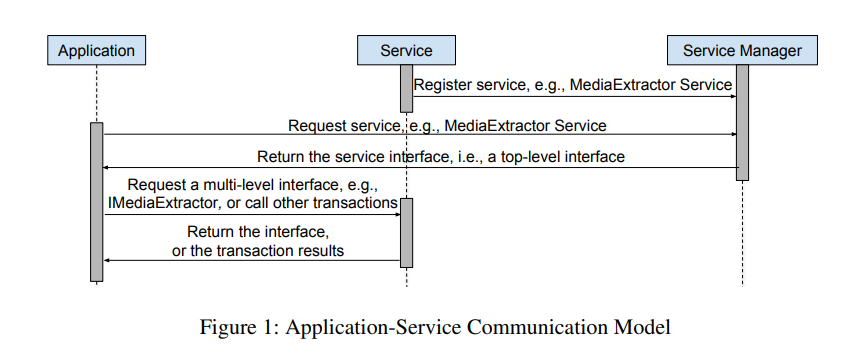
service向service manager注册自己;
service监听并响应application的调用,返回调用结果;
application向service manager请求目标service的interface(top-level interface);
application向top-level interface请求multi-level interface;
application调用目标interface的transaction完成动作;
2.2 Research Scope
Android native system service
相关经验可以推广到其他类别的service
3 Design
3.1 Design Choices
RPC-centric testing
测试系统服务,可以直接向系统注入服务可响应的事件,直接绕过RPC。
但是这种做法会因为生成了大量异常事件带来极高的误报率。
因为在实际中,攻击者与service的交互会经过IPC机制。
而IPC Binder会对数据进行安全检查,序列化操作也会受到系统状态的影响。
实现难度较大
所以,需要通过将生成数据注入IPC Binder机制,使得达到service的数据满足一定的语法语义特征,从而降低误报率。
Generation-based fuzzing
mutation-based fuzzing生成的测试数据容易出现语法错误或者语义错误,所以选择Generation-based fuzzing。
Learn input model from code
如何指导测试用例的生成?
grammar knowledge obtained manully: 大量人工参与,不能自动化
learn from transactions recorded:受数据集影响较大,有什么数据学到什么知识;容易忽略不常见的transaction
从源代码中挖掘输入模型的知识,input model knowledge is buried in the source code
3.2 Overview
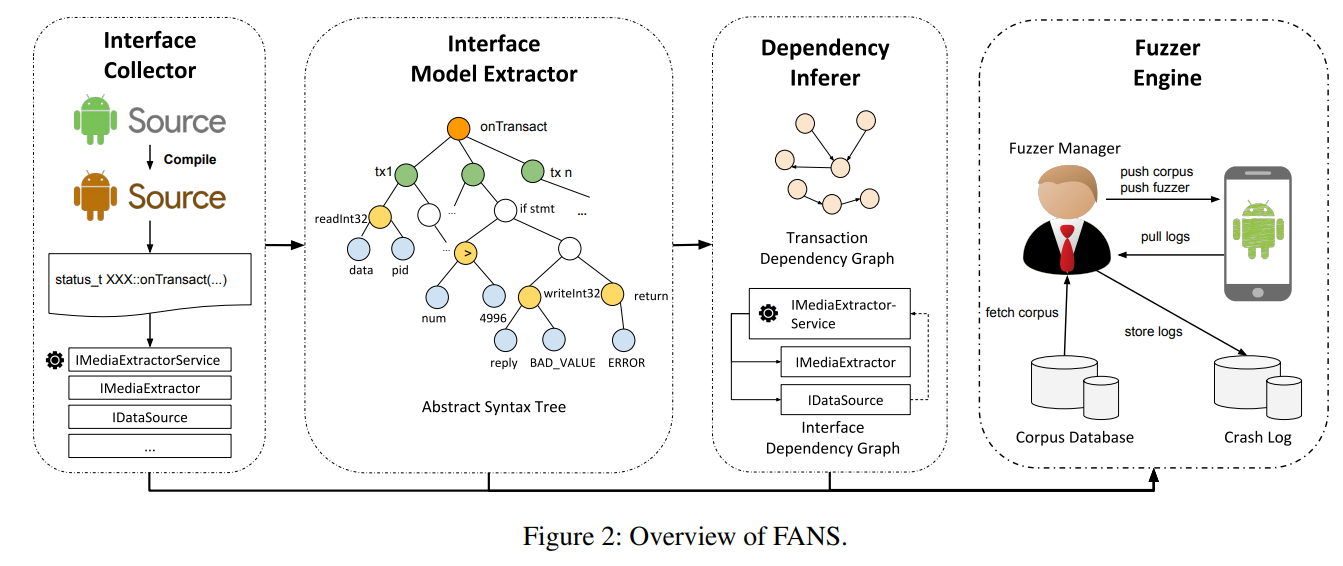
3.3 Interface Collector
每一个interface都会使用onTransact()方法来响应调用操作,可以根据这个知识来识别出所有的interface。
具体来说,FANS并不是直接扫描AOSP的所有C/C++源代码,而是扫描出现在编译命令中的所有C/C++源代码,这样子可以识别出通过AIDL动态生成的interface。
(存疑)
目前看来是把AOSP代码编译一遍,然后记录所有的编译命令,搜索编译命令中涉及到的文件,对去检查这些文件是否包含关于接口的代码。
这样子就可以检查到编译过程中通过AIDL动态生成的interface。
3.4 Interface Model Extractor
对interface建模
3 Principles
Complete-完备:所有的interface,所有的transaction
Precise-准确:要生成合法的输入通过IPC Binder的安全检查。(从变量模式、变量名和变量类型入手,也就是语法与语义都要合法)
Convenient-便捷:建模方法要简单。
Choices
选择深入分析server端的代码,以期达到更为准确全面的提取效果。
先使用工具将AIDL接口代码转化为C/C++代码,保留信息的准确性。
再建立AST提取onTransact()方法的信息。
Transaction Code Identification
Service->Interface->Transaction
一个Service可能有多个Interface,在一个Interface中,根据收到的code的不同,会进入不同的处理逻辑,称transaction。
具体到onTransact()方法中,interface会根据code将控制流分配到不同的transaction逻辑中。
一般会通过switch语句实现,case就是code值了。
所以建立了onTransact()的AST模型之后,不同的transaction就会形成不同的子树,由此识别出不同的transaction。
Variable Extraction
通过建立AST,获取interface-transaction输入输出的语法语义知识。 Gammar&Semantic
当完成了transaction代码的识别之后,需要进一步地识别出transaction从data中反序列化得到的所有输入变量。
因为要尝试推断inter-transaction依赖,所以还要识别向replay中序列化注入了哪些输出变量。
flag不需要fuzz,后文用于标记synchronized call和asynchronized call。
变量通过代码语句生效,从编码的角度而言,有顺序语句、条件语句和循环语句,这里再特别分类出返回语句,那么变量也有相应的4类。
Sequential Variable:
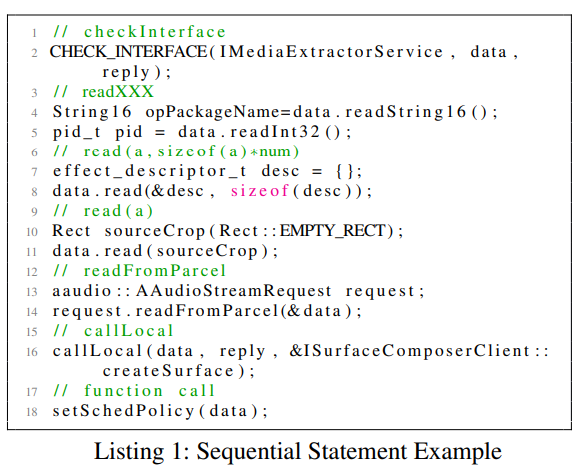
checkInterface(): 检查client端提供的token是否合法
readXXX(): readInt32, readString16
read(a, sizeof(a)*num): 读入一个原生数据结构
read(a): 读入一个可子序列化的对象 Flattenable&Light-Flattenable
readFromParcel(&data): 基于自己实现的反序列化方法获取对象
callLocal():
Misc: 调用其他函数处理,递归式识别
Conditional Variable

if&switch语句,将相关的变量(fd)作为conditional input
Loop Variable
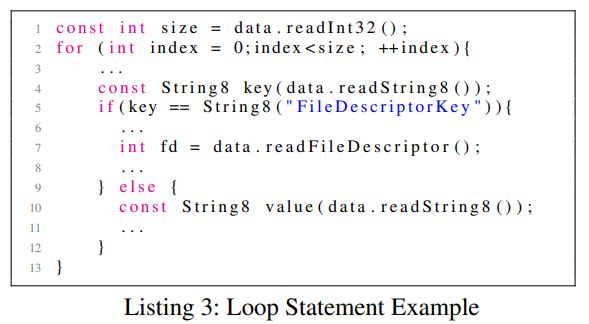
识别出循环语句内部的变量,记为loop variable
Return Variable

如果一条执行路径返回了ERROR_CODE,那么这条路径出现漏洞的概率更低。
虽然在fuzz的过程中,总是希望输入使得目标程序出现ERROR,但是这里的ERROR是程序本身识别抛出的,说明存在一定的安全检查逻辑。
所以会把这条执行路径降权,生成较少的测试用例来测试这条路径。
同时,会帮助建立准确的transaction间依赖关系。(存疑)
Besides, it will also help us generate explicit inter-transaction dependency, as inputs that do not satisfy the dependency usually fall back to error handling paths.
Type Definition Extraction
都可以通过AST完成
在基本类型之外,需要重点分析以下三类
structure-like: 联合体和结构体
Enumeration: 枚举类
Alias: typedef别名,注意命名空间namespace,避免冲突;可能会递归头文件
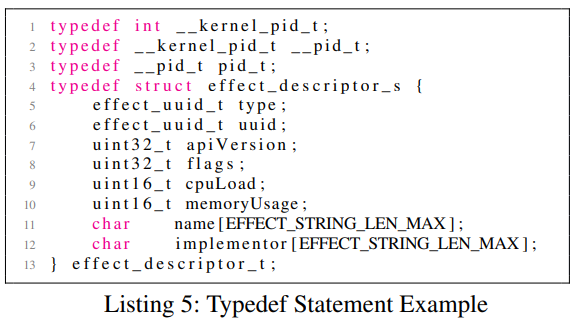
3.5 Dependency Inferer
interface dependency: how an interface is used by other interface
variable dependency in transaction
Interface Dependency
onTransact() write/readStrongBinder() 在interface extrector和interface dependency inferer中的作用不是非常明确。
用这两种方法标定interface?
还是说先用onTransact()标定top-level interface,然后用write/readStrongBinder确定依赖关系,同时标定multi-level interface?我认为是后者,因为在interface-colletor.py中还是单纯依赖
onTransact()函数名判断是否为interface related file【原文】Interface Acquisition: As for top-level interfaces, we can get them through the service manager. Multi-level interfaces can then be recursively obtained via the recognized interface dependency
Generation Dependency
如前所述,top-level interface会直接向servicemanager注册自己,直接被获取。
multi-level interface通过top/upper-level interface的返回来获取。
向A接口请求B接口,则A接口会调用**writeStringBinder()**方法向reply写入一个序列化的B接口,然后返回给调用者。
Use Dependency
如果B接口使用了A接口,那么B接口会调用readStrongBinder()方法从data中反序列化一个A接口出来用。
区别
A接口生成B接口,写入reply中给调用者使用。
B接口从接收的data中反序列化出来一个A接口使用。
Variable Dependency
intra-transaction
条件语句->条件依赖
循环语句->循环依赖
array类数据->array依赖,通常会有一个变量来声明array的长度,类似循环依赖
inter-transaction
一个transaction的input可能是另外一transaction的output。(两个transaction同属一个interface)
这里采取的是一些模糊的规则来建立跨transaction的两个变量之间的依赖(依据存疑)
- 一个变量是输入,一个变量是输出
- 处于不同的transaction
- 变量的类型相同 (primitive type)
- 要么输入变量的type不是基本类型,要么两者的变量名相似
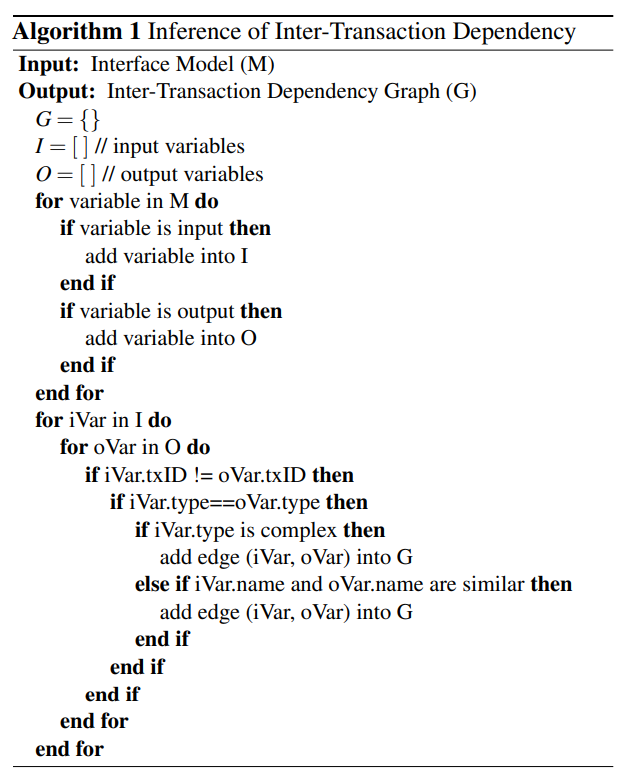
3.6 Fuzzer Engine
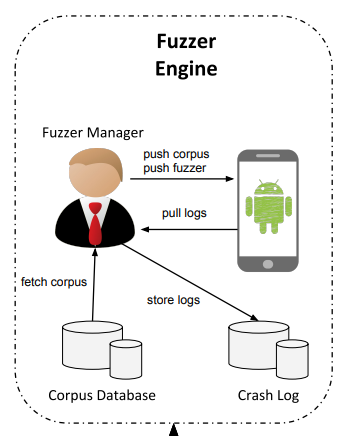
Fuzz工作在设备上进行
Manager将fuzzer和语料传递到设备上
fuzzer将日志数据传回用于分析
Principles of Transaction Generator
在生成transaction数据时,依次满足以下三个principle
约束:A变量是否存在取决于B变量,则在生成transaction时,先检查B变量
依赖:如果A变量可以通过一个transaction生成,则以较高的概率通过这个transaction生成一个A变量,以较低的概率不通过transaction生成
类型与名称:直接根据变量的类型和名称生成具体的值,例如根据opPackageName生成一个String16,根据pid生成一个int。
依赖原则是调用其他transaction生成数据,类型与名称原则是直接生成,相互矛盾。
如果有个变量A既可以通过transaction生成,也有type和name,如何处理?
依照原则的优先级,应该以较高概率使用依赖原则调用其他transaction生成数据,以较低概率直接直接生成。
4 Implementation
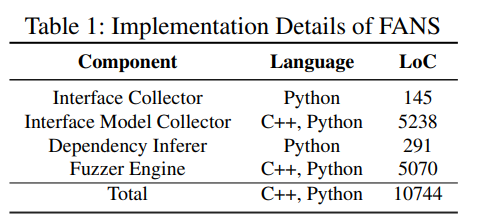
从零开始的FANS,而不是AFL-based。
搜索接口 Interface Collector
因为有的interface是通过AIDL动态生成的,所以这里是在编译AOSP源码的过程中记录编译命令,获取到interface和variable。
具体的原理尚不清楚,但是根据前文“并不是扫描整个AOSP源码”描述,猜测可能是通过编译命令涉及到的文件缩小搜索范围,根据onTransaction获取interface相关代码文件,然后提取interface model。
提取接口 Interface Model Extractor
使用Clang生成AST文件,只保留AST中与输入输出变量相关的节点,接着进行后续处理使其可以被fuzzer使用。(JSON格式)
依赖推断 Dependency Inferer
遍历AST,推断出interface的generation dependency和use dependency,
以及variable的inter-transaction dependency。
Fuzzer Engine
在host上的Fuzzer Manager会在多台设备上运行fuzzer、同步数据。
使用ASan检查内存错误
fuzzer以root权限运行
配置flag,表示是否需要接收reply,指定transaction是synchronous还是asynchronous
logcat+tombstones记录crash
5 Evaluation
Interface
Interface Collection
编译1小时,搜索几秒钟,共计68个interface。
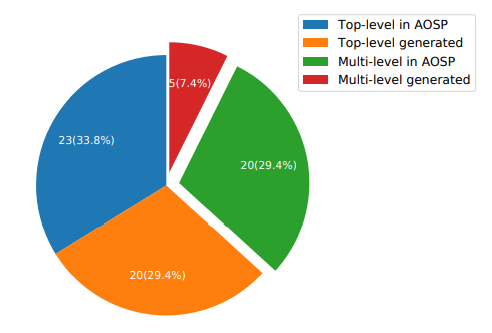
Interface Dependency
依赖关系图大致是有向无环图。
一个interface可以通过多个上级interface得到,于是从多条依赖路径来测试目标interface。
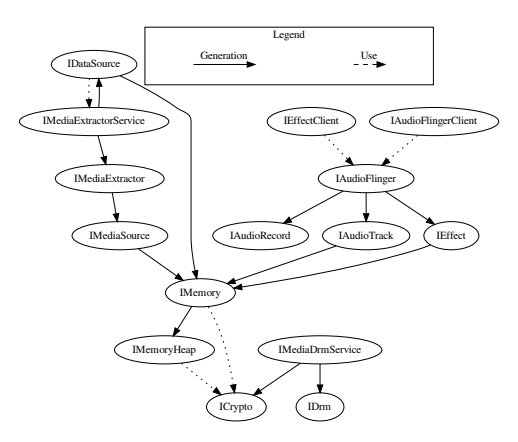
Interface Model 1375
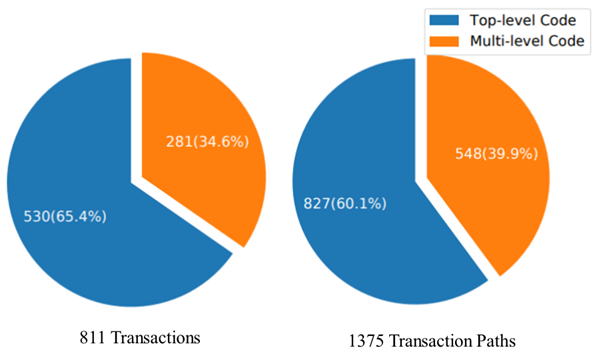
811个interface transactions,1375条transaction path,说明许多transaction有多条执行路径、多个返回可能。
statistices
多数变量是conditional variable
所有的别名操作(typedef)都是对三种基本变量的重组,内涵更多的语义信息。
Primitive、String之间的依赖较多
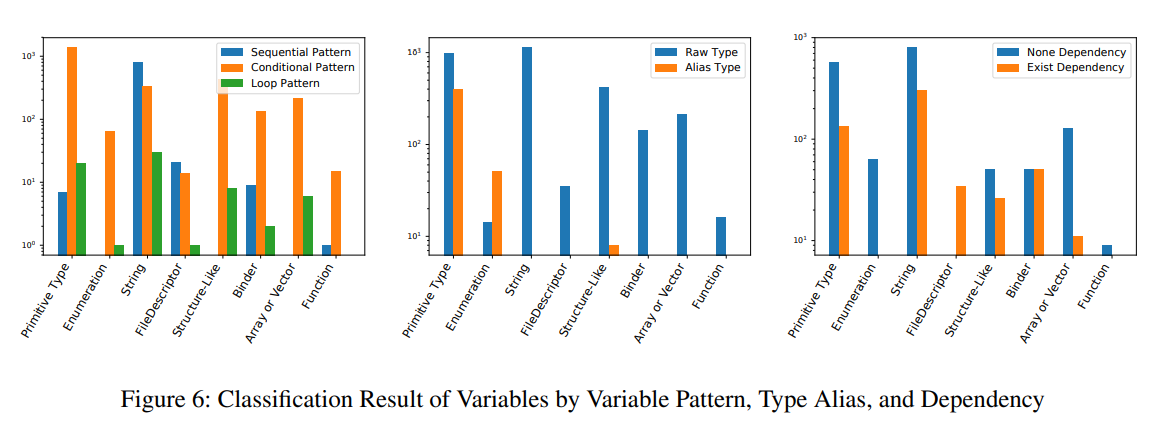
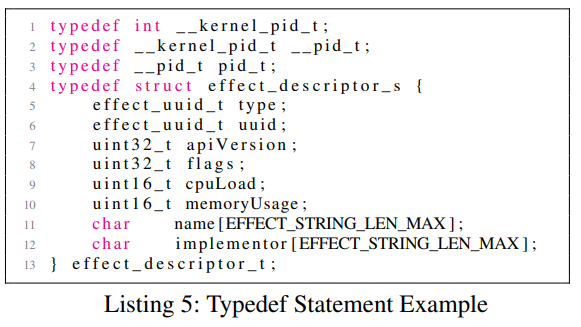
建模方法的准确性
因为没有可以对比的数据和研究,所以这里是随机选择了10个interface手动建模对比的。
not entirely precise but good enough
漏洞列表
共计30个漏洞,22个在Android native system service中, 5个在lib中,3个属于Linux的漏洞。
还触发了138个Java Exception
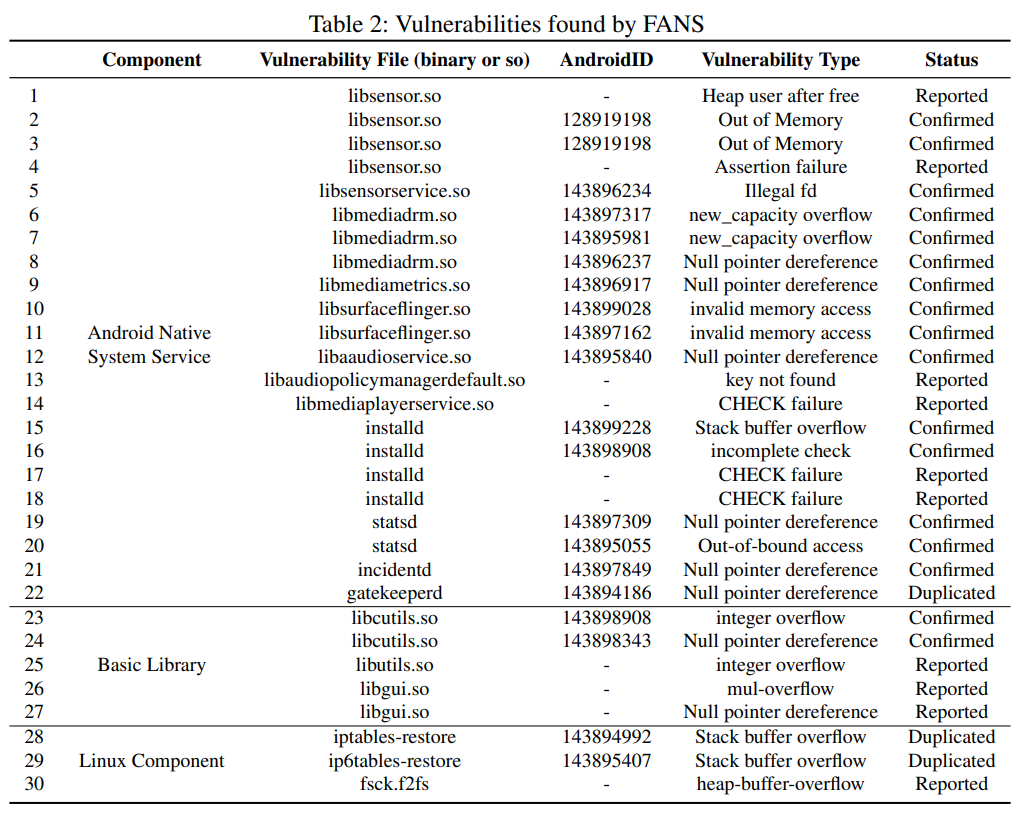
6 Discussion
对比评价
BinderCracker
开源 vs 闭源
基于input model vs 基于traffic学习
30+138 on 9.0 vs 89 on 5.1
automated vs manully [gong(first)]
native and promote vs vendor [Chizpurfle]
自我评价
Interface Model Accuracy
good enough but not entirely precise
loop次数的判定:如果不能准确确定,就使用loop的前一个变量。
用alias标识变量类型,但是使用时又用primitive type。
transaction dependency: 可能存在特定的调用顺序,服务可以被视作状态机 (?state-sensitive)
Coverage Guided Fuzzing
没有使用覆盖率知识
state-sensitive: 当前程序的coverage也还受到之前输入的影响。(Fork())
Fuzzing Efficiency
fuzzer以root权限运行,导致系统经常进入recovery模式。
然后就得手动重新刷机,影响实验效率。
Interface-based Fuzzing in Android
提出可以把本文的理论推广到vendor service和hardware service。
7 My View
测试部署架构,不够稳定,性能不够 -> 模拟器
FANS Code Review
android.googlesource.com访问有问题,使用aosp.tuna.tshinghua.edu.cn替换来git clone
python2,安装python2或者退出anaconda的base环境
1 | 可能需要安装以下库文件 |
1 | 我觉得日志最后输出这些就算编译好了 |
搜索相关教程,把Android Pie的编译流程走一遍。由命令make -j [N_PROCS] showcommands 2>&1 >cmd.txt,得到cmd.txt保存编译命令。
1 | 一行编译命令如下 |
1 Service Related File Collector
旨在收集与Android native system service相关的文件,具体来说,与以下主体相关:
- top-level & multi-level interface
- 标准的parcel、flattenable、lightFlattenable结构体
- 接收parcel类参数的函数
- 不使用readFromParcel&writeToParcel的特殊parcel结构体
大致流程如下:
- FANS分析
cmd.txt文件,提取AOSP编译过程中涉及到的cpp/cc文件,缩小搜索范围,同时排除特定目录下的文件和hardware相关的代码文件 - 枚举文件每一行代码,根据
status_t xxxxx::onTransact(的模式确定包含的interface,将interface和当前文件file关联 - 如果代码包含interface,那显然是interface-related
- 如果代码中有
readFromParcel、writeToParcel、flatten、unflatten关键字,说明可能与interface交互,也是interface-related的 - 如果代码中有包含
misc_parcel_related_function或者special_parcelable_function,也视作是interface_related的 - 最后输出两个文件,记录interface与所在文件路径的json格式文件[interface2file.json],记录所有interface-related file的文件[service_related_file.txt]。
2 Interface Model Extractor
2.1 Pre-Procees
根据readme.md,似乎得先把llvm以及clang-6.0配置好再运行gen_all_related_cc1_cmd.py。
gen_all_related_cc1_cmd.py又把cmd.txt拿出来分析,把AOSP编译过程中涉及到clang编译的命令记录筛选出来。(”-v 2>&1”,把错误输出也定向到标准输出),然后把结果保存为json,键值关系是<filepath,cmd_result>。
extract_from_ast.py把前一步得到的cmd_result拿出来,把aosp_clang_location替换为manually_build_clang_location,同时修改了一些其他的编译配置,然后去执行编译一遍。最后检查命令行的输出结果,确保编译顺利完成。
考虑到在上述两者之间,我们还手动编译了BinderIface,需要搞懂它的作用。这里面涉及到了一些AST的东西。
同时需要注意的是,整个pre-process的工作都还是只提取interface/service related information,真正的处理还是得看post-process。
BinderIface
VisitTypedefDecl(): 似乎是记录编译目标cpp/cc时,涉及到的变量类型的alias和type,将其保存在typemap<underlyingType, qualifiedName>中。
暂时姑且认为BinderIface已经完成了对interface的AST操作。
Corner Case
在部分代码中,switch case语句并没有按照一定格式优雅地编写,需要手动调整这一小部分代码,便于后续处理。具体的细节在pre-process/misc.md中。
2.2 post-process
init.sh
重置一些目录和文件,然后调用init.py。处理一下pre-process中收集到的underlyingType与qualifiedName。
简单来说就是借用并查集操作,把各级别名与对应的基本类型直接关联起来。
从文件操作上来看,读入rough_interface_related_data_dir/typemap.txt,输出interface_model_extractor_dir/simplified_typemap_file.txt。